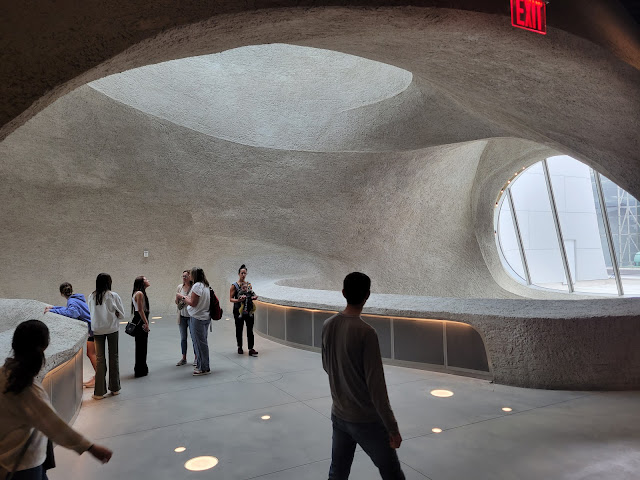I got around to visiting the new Gilder Center by Studio Gang at the American Museum of Natural History last weekend, and it's visually stunning. It's a grand cavern, with stairs and stadium seating at the focal point. It's breathtaking. It's also a little heartbreaking.
If you need an elevator, if you rely on a wheelchair or you're pushing a stroller, you don't get to be part of the main event. Follow the sign; your place is in the back corner.
Wayfinding signs are necessary, since the architecture does not naturally attract you away from the central gathering space and intuitive main circulation. And beyond the rough shotcrete walls, the elevators are an entirely sleek, utilitarian affair. They are completely apart from the brilliant naturalistic esthetic that makes this section of the museum so engaging and memorable.


When the elevator doors open upstairs, it is not into a dramatic view of an architectural space, but rather an artificially lit, whitewashed wall with the fire extinguisher. It does not compare well with the experience of climbing the main stairs and opening onto the floor above as the shapes formed by the curving walls frame constantly changing views and variations of natural lighting.
Unlike the dramatic architecture of the Long Island City Library by Steven Holl that has now come in for disdain, the Gilder Center does not violate the Americans with Disabilities Act (ADA). When I visited the library shortly after it opened, I immediately recognized the problem with the bookshelves that extend from landings on the stairs, inaccessible to anyone with difficulty navigating the stairs. This failure has the building mired in lawsuits.
Yet there is a fundamental similarity between the two designs in the way they use a dramatic staircase as the central feature, without making that experience inclusive for everyone. Although the Gilder Center fails as universal design, it stays within bounds of the ADA by providing some physical way to access all of the museum's programmatic areas. Ultimately, this may be more insidious, because it does not draw the criticism it deserves. Instead, visitors captivated by the compelling visuals will post their favorite photos and smiling selfies.









No comments:
Post a Comment